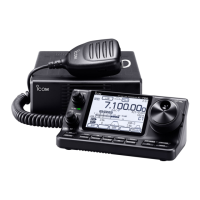13
USING AN SD CARD
13-10
A backup file allows easy restoring even if the setting
data in the SD card is accidentally deleted.
Depending on your PC, a memory card reader (pur-
chase locally) may be additionally required to read the
SD card.
D About the SD card’s folder contents
The folder in the SD card contains the following:
IC-7100 folder q
The folders created in the IC-7100 are contained in
this IC-7100 folder.
Decode folder w
The RTTY decode folder is created.
RTTY folder e
The transmitted or received RTTY decode data is
stored in the “txt” format.
The file format can be changed to “html” in the RTTY
DECODE LOG SET screen.
QSO Log r
QSO log data is stored in the “csv” format.
Reply folder t
Automatic reply data is stored in the “wav” format.
RxLog y
RX record log data is stored in the “csv” format.
Setting folder u
The transceiver’s setting data is stored in the “icf”
format.
Voice folder i
The recorded QSO audio date folders are created in
the Voice folder.
yyyymmdd folder o
Recorded audio file is stored in the “wav” format.
The folder name is automatically created in the fol-
lowing format:
yyyymmdd (yyyy:Year, mm:month, dd:day)
!0 VoiceTx
Recorded voice audio data for the Voice TX function
is stored in the “wav” format.
Click
Click
The setting
data
Click
(Example: Selecting the setting data)
When the SD card is inserted into the SD card drive of your
PC or the SD card reader (purchase locally), the screen ap-
pears as shown below.
IC-7100 q
Decode w
Reply t
Setting u
Voice i yyyymmdd o
yyyymmdd o
QsoLog r
RxLog y
!0 VoiceTx
Backing up the data stored on the SD card onto a PC
Rtty e

